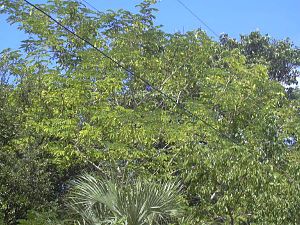Note: This is a project under development. The articles on this wiki are just being initiated and broadly incomplete. You can Help creating new pages.
Albizia lebbeck - Shirisha
Shirisha is a beautiful large deciduous tree found throught India and up to 900m in the Himalayas. The greenish-yellow flowers appear in abundance during the summer filling the air with a rich aroma.
Uses
Inflammation, Herpes, Skin diseases, Cold, Cough, Gastric, Blotches, Pimples, Diarrhea, Sore throats, Asthma, Toothache[1]
Parts Used
Chemical Composition
Flavonoids, triterpenoids and triterpenoid saponins; oleanolic acid, albigenic acid, albigenin and acacic acid. The bark contains 7–11% condensed tannin; also d-catechin and d-leucocyanidin. Alcoholic extract of stembark contains cardenolide glycosides of digitoxin nature. [3]
Common names
| Language | Common name |
|---|---|
| Kannada | Baage mara, Kallu baage |
| Hindi | Siris, Siras |
| Malayalam | Chelinge, Kattuvaka, Nenmani, Nenmeni |
| Tamil | Vaagai, Vellaivenkai, Kattuvakai |
| Telugu | Baagichettu, Billa, Billa vaara, Dirisana, Dirisanamu, Sirasamu |
| Marathi | NA |
| Gujarathi | NA |
| Punjabi | NA |
| Kashmiri | NA |
| Sanskrit | Shirisha, Krishnashirisha, Mridupushpa, Shukapushpa, Vishanashana |
| English | Siris |
Properties
Reference: Dravya - Substance, Rasa - Taste, Guna - Qualities, Veerya - Potency, Vipaka - Post-digesion effect, Karma - Pharmacological activity, Prabhava - Therepeutics.
Dravya
Rasa
Kashaya (Astringent), Tikta (Bitter), Madhura (Sweet)
Guna
Tikta (Bitter), Rooksha (Dry), Teeksha(Piercing)
Veerya
Ishat Ushna (Slightly hot)
Vipaka
Katu (Pungent)
Karma
Kapha, Pitta, Vata
Prabhava
Habit
Identification
Leaf
| Kind | Shape | Feature |
|---|---|---|
| Bipinnate | Alternate | Pinnae 2-4 pairs, 5.5-12 cm long, slender, glabrous, opposite, even pinnate, leaflets 8-20, opposite, even pinnate, petiolule to 1 mm long, a gland in between each leaflets, 2.7-5 x 1-2.5 cm |
Flower
| Type | Size | Color and composition | Stamen | More information |
|---|---|---|---|---|
| Bisexual | 3.5-3.7 cm long | Greenish-white | Many | Solitary or 2-4 together in axillary corymbose racemes; peduncle 6-8 cm; bracts linear, cauducous; Pedicels to 3 mm. Flowering from March to May |
Fruit
| Type | Size | Mass | Appearance | Seeds | More information |
|---|---|---|---|---|---|
| A pod | 20-30 x 4-5 cm | Flat, oblong, compressed, straw coloured, base and apex obtuse, turgid above the seeded region | Seeds 8-12, 6-10 x 5-8 mm, ovate, dull dark brown, flattened. | Fruiting from March to May | {{{6}}} |
Other features
List of Ayurvedic medicine in which the herb is used
Where to get the saplings
Mode of Propagation
How to plant/cultivate
Can be easily grown from seed.
Commonly seen growing in areas
Photo Gallery
References
- ↑ Uses
- ↑ ”Karnataka Medicinal Plants Volume-3” by Dr.M. R. Gurudeva, Page No.767, Published by Divyachandra Prakashana, #6/7, Kaalika Soudha, Balepete cross, Bengaluru
- ↑ Chemical composition
- ↑ Vernacular names
- ↑ BOTANIC DESCRIPTION
External Links
- Ayurvedic Herbs known to be helpful to treat Inflammation
- Ayurvedic Herbs known to be helpful to treat Herpes
- Ayurvedic Herbs known to be helpful to treat Skin diseases
- Ayurvedic Herbs known to be helpful to treat Cold
- Ayurvedic Herbs known to be helpful to treat Cough
- Ayurvedic Herbs known to be helpful to treat Gastric
- Ayurvedic Herbs known to be helpful to treat Blotches
- Ayurvedic Herbs known to be helpful to treat Pimples
- Ayurvedic Herbs known to be helpful to treat Diarrhea
- Ayurvedic Herbs known to be helpful to treat Sore throats
- Ayurvedic Herbs known to be helpful to treat Asthma
- Ayurvedic Herbs known to be helpful to treat Toothache
- Herbs with Leaf used in medicine
- Herbs with Root used in medicine
- Herbs with Seed used in medicine
- Herbs with common name in Kannada
- Herbs with common name in Hindi
- Herbs with common name in Malayalam
- Herbs with common name in Tamil
- Herbs with common name in Telugu
- Herbs with common name in Sanskrit
- Herbs with common name in English
- Habit - Tree
- Index of Plants which can be propagated by Seeds
- Herbs that are commonly seen in the region of Tropical area
- Herbs that are commonly seen in the region of Road sides
- Herbs
- Fabaceae








